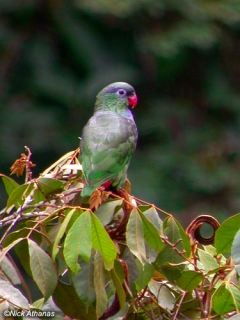Red-billed Parrot |
|
|
Also known as: Sordid Parrot, Coral-billed Parrot or Pionus, Red-billed Pionus
Photos
View in GalleryDid You Know?
The Red-billed Parrot, also called the Coral-billed Pionus, is able to withstand some habitat disturbance, unlike many other species of parrot.Academic Research
Related publications: Pionus sordidusSpecies Profile
Genus: Pionus | Species: sordidus
Size:
28cm (11 in)
Weight:
255-275g (9-9.6 oz)
Subspecies including nominate:
five: P.s. sordidus, P.s. antelius, P.s. ponsi, P.s. saturatus, P.s. corallinus
Colour Adult:
P.s. sordidus: Both adults olive/green head, with broad dark blue edging to feathers of crown and occiput; olive cheeks, with blue tipped feathers; blue band on throat blue, chin blue; dull olive underparts, lightly washed dull pink; red undertail coverts, with tips lightly yellow/green; olive/green upperparts; green tail with red at base. Bill red. Eye ring pale grey. Eye grey.
P.s. antelius: Both adults paler than sordidus, more yellow/green; green throat with blue band minimal or absent; pink wash on underparts absent; olive/yellow abdomen with paler margins to feathers. Smaller in size.
P.s. ponsi: Both adults darker green than sordidus, blue band on throat absent; pink on chest minimal or absent.
P.s. saturatus: Both adults as in ponsi, but with paler, more yellow/green lesser wing coverts and upper tail coverts; paler green abdomen and flanks, less olive.
P.s. corallinus: Both adults dull green, paler edges to feathers absent; blue edging to feathers of head; purple/blue chin and band across throat. Larger in size.
Colour Juvenile:
P.s. sordidus: Pale green head, throat and breast; yellow/green under tail coverts, with varying red marks.
Call:
Calls in flight are harsh; thinner and more high-pitched than similar call of Blue-headed Parrot.
Listen NowVideo Links:
Video 1 | Video 2 | Video 3More Information:
Content Sources:
CITES
BirdLife International
Cornell Lab of Ornithology/Birds of the World
Parrots: A Guide to Parrots of the World, Juniper and Parr, 1998
ML Media Collection Catalogue 68640, Red-billed Parrot Pionus sordidus, Schwartz, Paul, Aragua, Venezuela, Feb. 22, 1965, Cornell Lab of Ornithology. Site
Parrots of the World, Forshaw and Cooper, 1977. 2010 edition
Parrots of the World, Forshaw, 2006.
Parrots in Aviculture, Low, 1992.
Photos
View in GalleryDid You Know?
The Red-billed Parrot, also called the Coral-billed Pionus, is able to withstand some habitat disturbance, unlike many other species of parrot.Academic Research
Related publications: Pionus sordidusSpecies Care
Captive Status:
Uncommon
Longevity:
20-25 yrs
Housing:
Aviary or suspended enclosure, minimum length 2-3m (6.5-9.8 ft).
Diet:
Fruit such as: apple, orange, banana, pomegranate, cactus fruits, forming about 30 percent of the diet; vegetables such as: carrot, celery, green beans, peas in the pod, fresh corn; green leaves such as: Swiss chard, lettuce, sowthistle, dandelion, chickweed; spray millet; small seed mix such as: millet, canary, and smaller amounts of oats, buckwheat, safflower and a little hemp; soaked and sprouted sunflower seed; cooked beans and pulses, boiled maize and complete pellet.
Enrichment:
Quite active; provide baths, socialization, toys such as bird-safe wood and vegetable-tanned leather chew toys, ladders, swings; non-toxic, non-sisal ropes.
Nest Box Size:
Vertical box 10" x 10" x 20" (25.4cm x 25.4cm x 51cm).
Clutch Size:
3
Incubation Time:
26 days
Fledging Age:
9-10 weeks
Hatch Weight:
Not recorded.
Peak Weight:
Not recorded.
Weaning Weight:
Not recorded.
Photos
View in GalleryDid You Know?
The Red-billed Parrot, also called the Coral-billed Pionus, is able to withstand some habitat disturbance, unlike many other species of parrot.Academic Research
Related publications: Pionus sordidusSpecies Wild Status
World Population:
Unknown, decreasing.
IUCN Red List Status:
Least Concern
CITES Listing:
Appendix II
Threat Summary:
Not globally threatened. Fairly common in most of its range in moderately disturbed habitat; perhaps less so in W Ecuador but one of the most common parrots at altitude in La Paz, N Bolivia. Forest clearance in Venezuela and Colombia likely has caused local declines with all three races especially at risk in Venezuela. Race antelius has not been found in a recent survey of its extensively cleared habitat. Little traded internationally.
Range:
P.s. sordidus: Highlands of NW Venezuela.
P.s. antelius: Highlands of NE Venezuela.
P.s. ponsi: NW Venezuela and N Colombia.
P.s. saturatus: Sierra Nevada de Santa Marta district, N Colombia.
P.s. corallinus: Eastern slope of Cordillera Oriental in Colombia south to Andean slopes in Ecuador and N Peru, and E Andean slope in W Bolivia.
Habitat:
Found from 350-2000m (1148-6560 ft) in humid forest, including montane rainforest and cloud forest, in subtropical and upper tropical zones. Often found in secondary growth, partially deforested areas with scattered tall trees and sometimes light woodland near coffee plantations.
Wild Diet:
Eats fruits, blossoms, berries and seeds.
Ecology and Behaviour:
Social outside of breeding season, forming flocks of up to 50 birds, often where food is abundant. Small numbers roost communally.
Clutch and Egg Size:
3 rounded eggs, 33.0 x 22.5mm (1.3 x 0.9 in).
Breeding Season:
February-April, Colombia; April, Venezuela; January-May, Ecuador; October, Bolivia. Nest is in tree hollow.
Photos
View in GalleryDid You Know?
The Red-billed Parrot, also called the Coral-billed Pionus, is able to withstand some habitat disturbance, unlike many other species of parrot.Academic Research
Related publications: Pionus sordidusMembers Only Resources
Please log-in now to find more research, resources and tools.
Not a Member?
Find more great information:
Gain exclusive access to 600+ pages of additional research, seminars and podcasts, specialists to ask your toughest questions, and dozens of other fun resources - when you become a WPT member.
Join Today >>

































